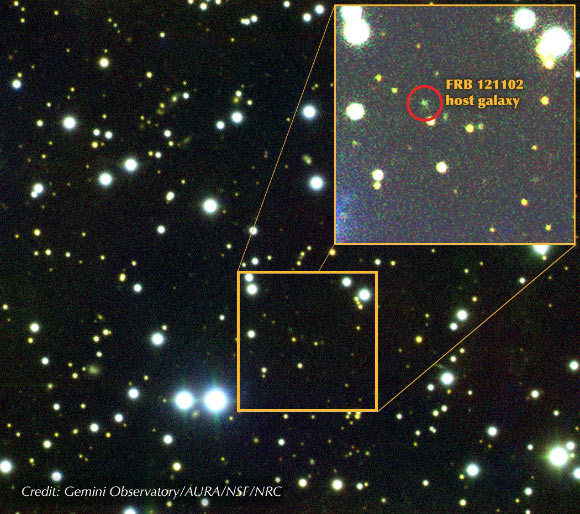A large international team of astronomers has uncovered the cosmological source of a repeating ‘fast radio burst’ known as FRB 121102.

The globally distributed dishes of the European VLBI Network are linked with each other and the 305-m William E. Gordon Telescope at the Arecibo Observatory in Puerto Rico. Together they have localized FRB121102’s exact position within its host galaxy. Image credit: Danielle Futselaar, www.artsource.nl.
Fast radio bursts (FRBs) are powerful, rarely detected bursts of energy from space.
Astrophysicists estimate that there are between 2,000 and 10,000 FRBs occurring in the sky every day.
These events have durations of milliseconds and exhibit the characteristic dispersion sweep of radio pulsars. They emit as much energy in one millisecond as the Sun emits in 10,000 years, but the physical phenomenon that causes them is unknown.
The first FRB was discovered in 2007, although it was actually observed some six years earlier, in archival data from a pulsar survey of the Magellanic Clouds.
There are now 18 known FRBs. All were detected using single-dish radio telescopes that are unable to narrow down the object’s location with enough precision to allow other observatories to identify its host environment.
Unlike all the others, however, FRB 121102, discovered in November of 2012 at the Arecibo Observatory in Puerto Rico, has recurred numerous times — a pattern first detected in late 2015 by Dominion Radio Astrophysical Observatory astronomer Paul Scholz.
Rising just ahead of the winter constellation Orion, FRB 121102 has a home in the constellation Auriga.
“There’s a patch of the sky from which we’re getting this signal — and the patch of the sky is arc minutes in diameter. In that patch are hundreds of sources. Lots of stars, lots of galaxies, lots of stuff,” said team member Dr. Shami Chatterjee, an astronomer at Cornell University.
The repeating bursts from FRB 121102 allowed astronomers to watch for it in 2016 using NSF’s Karl G. Jansky Very Large Array (VLA). In 83 hours of observing time over six months in 2016, they detected nine bursts.
Using the precise VLA position, the team used the Gemini North telescope on Maunakea in Hawai’i to make a visible-light image that identified a faint dwarf galaxy at the location of the bursts.
Spectroscopic data from Gemini also enabled the astronomers to determine that the dwarf galaxy is more than 3 billion light-years from Earth.
“While the exact cause of the high-energy bursts remains unclear, the fact that this particular FRB comes from a distant dwarf galaxy represents a huge advance in our understanding of these events,” Dr. Chatterjee said.
“The host galaxy for this FRB appears to be a very humble and unassuming dwarf galaxy, which is less than 1% of the mass or our Milky Way galaxy,” said team member Dr. Shriharsh Tendulkar, an astronomer at McGill University.
“That’s surprising. One would generally expect most FRBs to come from large galaxies which have the largest numbers of stars and neutron stars — remnants of massive stars.”
“This dwarf galaxy has fewer stars, but is forming stars at a high rate, which may suggest that FRBs are linked to young neutron stars.”
“There are also two other classes of extreme events — long duration gamma-ray bursts and superluminous supernovae — that frequently occur in dwarf galaxies, as well.”
“This discovery may hint at links between FRBs and those two kinds of events.”

Gemini composite image of the field around FRB 121102 (indicated). The dwarf host galaxy was imaged, and spectroscopy performed, using the Gemini North telescope. Image credit: Gemini Observatory / AURA / NSF / NRC.
In addition to detecting the bursts from FRB 121102, the VLA observations also revealed an ongoing, persistent source of weaker radio emission in the same region.
Next, the team used the European VLBI Network (EVN), along with the William E. Gordon Telescope of the Arecibo Observatory, and NSF’s Very Long Baseline Array (VLBA) to determine the object’s position with even greater accuracy.
“These ultra-high precision observations showed that the bursts and the persistent source must be within 100 light-years of each other,” said team member Dr. Jason Hessels, of the Netherlands Institute for Radio Astronomy and the University of Amsterdam.
The next big question is ‘what powers FRB 121102?’ “We think it may be a magnetar – a newborn neutron star with a huge magnetic field, inside a supernova remnant or a pulsar wind nebula – somehow producing these prodigious pulses,” Dr. Chatterjee said.
“Or, it may be an active galactic nucleus of a dwarf galaxy. That would be novel.”
“Or, it may be a combination of those two ideas – explaining why what we’re seeing may be somewhat rare.”
The characterization of the host galaxy was published in the Astrophysical Journal Letters, and accompanied the team’s results on a campaign to precisely locate FRB 121102, published in the journal Nature.
_____
S. Chatterjee et al. 2017. A direct localization of a fast radio burst and its host. Nature 541, 58-61; doi: 10.1038/nature20797
S.P. Tendulkar et al. 2017. The Host Galaxy and Redshift of the Repeating Fast Radio Burst FRB 121102. ApJL 834, L7; doi: 10.3847/2041-8213/834/2/L7
B. Marcote et al. 2017. The Repeating Fast Radio Burst FRB 121102 as Seen on Milliarcsecond Angular Scales. ApJL 834, L8; doi: 10.3847/2041-8213/834/2/L8







